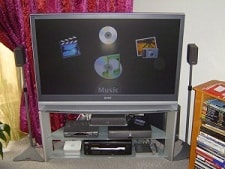Almost 10 years ago, my wife and I did something we had previously considered unthinkable – we canceled our cable TV and sold our televisions. We did this for a couple of reasons: namely, we didn’t watch enough TV to justify the monthly expense (almost $75 per month for basic cable), and we were relocating to a new state and didn’t want to haul the heavy TVs with us. We moved into a short-term rental home while we were searching for a house to buy, so we decided to wait a few months before purchasing a new TV.
It didn’t take me long to realize I didn’t miss cable and didn’t need to replace it. But I did miss watching movies and the occasional live sporting event. As for cable TV – I don’t think we will get it again. Instead, we plan on replacing cable TV with free and inexpensive alternatives to fit our TV needs. This will include the network channels over the air, streaming TV shows and movies online, and watching videos on DVD or Blu-Ray.
Here are a few things you should know before making the decision to cut the cord on cable TV.
Cutting the Cord on Cable TV Had Huge Impacts
There are many benefits to cutting cable TV. The two major benefits we experienced were more time and more money. Who couldn’t use more of both of those?!
The first change is time
TV can suck you in and not let you go. It’s easy to justify killing 15 or 20 minutes when you have a few minutes of downtime. But sometimes that 15 or 20 minutes can turn into an hour or two. We are now more intentional with what we watch and when we watch it. Channel surfing is a thing of the past. I find TV much more enjoyable when I plan my viewing time – that way I don’t feel guilty or feel like I could be doing something more productive.
The second change is our budget
Our cable and internet package was roughly $90 per month, and this was about 7 or 8 years ago. Prices have since risen quite a bit in most markets. That was too expensive for what we got out of it (the base TV package, with no premium channels, was over $50 a month after the introductory price expired). We only rarely watched TV, and then it was usually limited to a few channels. We cut the cable TV service and elected to pay for faster internet service. We pay a lot for Internet service, but we are paying for a service we use.
Should You Drop Cable TV?

The first thing I will admit is this isn’t for everyone. If you love watching TV and it fits your schedule and budget, then go for it. That said, I encourage you to continue reading.
This article is for anyone who wants to save money on their TV experiences, or for anyone who doesn’t have the time, budget, or desire to continue paying a lot of money for cable TV.
You may find ways to reduce your cable TV package and find less expensive ways to watch your favorite movies, shows, or sporting events.
Assess your TV watching habits and needs
Even if you love your TV and your cable subscription, I encourage you to take a few minutes and review both your plan and your watching habits. See which channels you are paying for, and which you actually watch. Then see if there is a way you can get them cheaper, or do without.
For example, many people can replace premium movie channels with streaming TV services such as Netflix or Amazon Prime. You may find that you are paying for a premium cable package, but you only watch a few of the channels. If this is the case, you may be able to buy them online or work out a discount through your cable provider.
There are free and premium alternatives
The next thing to do is look at the alternatives. For example, most network channels are now broadcast over the air in HDTV and you can watch them for free (many markets now broadcast more channels than they did a few years ago because the new signals take up less bandwidth). You can also find many TV shows free online, although these are sometimes shown a week after they were originally broadcast. Check with your favorite network website to see which shows are available.
Required Hardware to Drop Cable TV – Antennas and Streaming Boxes
If you are planning on dropping cable and using alternatives, you need to be aware that you may need to make a few purchases – or you may already have the equipment in your home.
If you have an older TV you may need to buy an antenna capable of converting HDTV data to your analog TV. These are already installed in many newer TVs, or they can be purchased for around the cost of a month of basic cable TV service. A digital antenna will also allow you to watch live network television over the air. This is how we watch many live sporting events at home, such as the Super Bowl and World Series.
Many newer Smart TVs make it easy to stream directly from services like Netflix, Amazon Prime, and others. But if your TV doesn’t offer this feature, you may also need a converter to stream internet shows to your TV. These can be found in some devices such as an Xbox, PlayStation 3, Roku, Apple TV, Google Chromecast, Apple Fire TV, certain BluRay players, and other devices. The price of these ranges from around $50 and up.
You will also need a high-speed internet connection to be able to stream quality content to your TV. It’s usually recommended to have a connection of 10-12 MB per second or faster for high-quality streaming video. That said, many people already have the technology in place – they just need to spend some time working out a scenario that works for them.
More Alternatives to Cable TV
Streaming TV Options: Some of the more popular streaming TV options include:
- Amazon Prime Video
- Hulu
- iTunes
- HBO Now
- Netflix
- Sling TV
- Philo
Most of these plans have different levels and options, depending on which plan you sign up for. My personal favorites for movies and documentaries include Amazon Prime Video and Netflix. If you want to watch more on-demand television, you may be better off going with Hulu. Hulu Plus and Hulu Live allow you to stream live network shows, including sports and other live events. You can compare Hulu and Hulu Plus in this review.
Network Websites: Some network websites also feature the ability to stream shows. But this option is more restrictive than using the streaming services like Netflix and Hulu.
- ABC
- NBC
- CBS
- Fox
- Lifetime
- A&E
- MTV
- HGTV
- Discovery Channel (Discovery Channel, Animal Planet, and TLC)
- PBS
You can also find many television shows on Youtube.com. The video-sharing site is not actually intended for television shows, but many people take the time to record and upload their favorite television series. You will have to watch more than one video to get a complete episode, but they’re typically labeled with the name of the show, the episode number, and then “video 1” or “video 2”, so you can piece together the various videos you need to watch to see the whole show. While a little inconvenient, if the goal is to save money, even Youtube.com is a good option for cutting your $60 or $130 cable bill!
Don’t forget your local library! Most libraries stock a wide range of videos and DVDs of movies and television series. You can borrow them for free just as you would books.
Reducing your fixed expenses is one of the best ways to reach financial freedom, and dropping your cable TV costs is a great way to free up cash flow every month. Even dropping cable and adding a service like Hulu, Amazon Prime, or Netflix can save you several hundred dollars per year.
More Tips on Cutting Cable TV
You need to be flexible and patient.
If there is a show or sporting event you absolutely must watch, then dropping cable may not be for you. Not all shows are streamed online and some sporting events are spotty at best. But if you are flexible regarding the shows you must watch or when you watch them, then you can probably drop cable and save a lot of money in the process.
Dropping cable TV isn’t for most die-hard sports fans.
You should be able to watch many sporting events on the network channels for free, but dropping cable TV completely would eliminate ESPN and other sports networks.
There is good news and bad news to this: Several major sports offer season passes that can be streamed online, but not all sports offer this yet. For example, MLB.tv offers very competitive rates for season access to all the major league games, as well as an interactive user interface, live stats, and more. The cost might seem expensive at over $100 a year, but that is about 2 months of basic cable TV in many markets. If you are a huge baseball fan, then this may be an excellent compromise between subscribing to cable and getting your baseball fix.
Most major sports offer a similar season pass that makes it easy to stream a season’s worth of sporting events for a reasonable cost. This can also be an excellent way to watch sporting events that are outside your local area or avoid the dreaded blackouts featured in certain sports.
Dropping Cable TV is all About Choice
To be clear – this article isn’t about bashing the cable TV industry. It’s about reassessing which areas of your budget are actually essential to you and which bring you pleasure. It’s about conscious spending and making informed decisions. For my wife and I that meant dropping cable. But that’s fine. We get more joy out of spending that money elsewhere, like eating at a nice restaurant or saving for a vacation.
photo credit: horrortaxi.



About the comments on this site:
These responses are not provided or commissioned by the bank advertiser. Responses have not been reviewed, approved or otherwise endorsed by the bank advertiser. It is not the bank advertiser’s responsibility to ensure all posts and/or questions are answered.